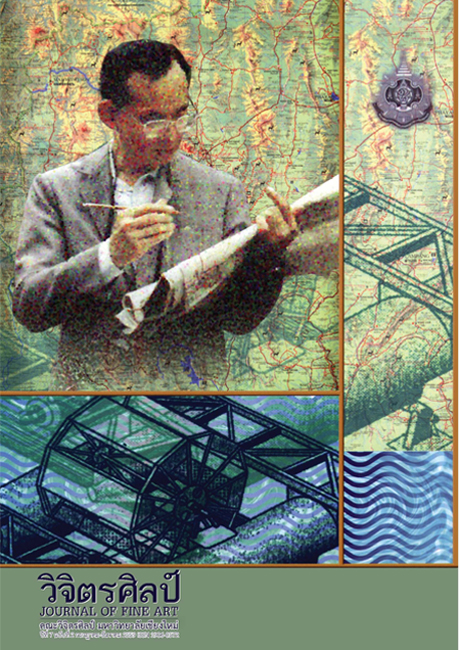จากความมืดมนสู่แสงสว่างในมือเรา: การสร้างกระบวนการทางศิลปะกับทฤษฎีจิตวิทยา เพื่อกระตุ้นและสนับสนุนการแสดงออกอย่างอิสระของเด็กผู้พิการทางสายตา
Main Article Content
Abstract
คนตาบอดนั้นสามารถรับรู้ หรือเรียนรู้ถึงสิ่งต่างๆ ได้โดยอาศัยประสาทสัมผัสต่างๆ ที่เขามีอยู่ การฝึกใช้ประสาทสัมผัสต่างๆ ตั้งแต่วัยเด็กเป็นสิ่งที่สำคัญมาก ควรต้องฝึกด้วยวิธีการต่างๆ ให้เร็วที่สุด และควรจะต้องระลึกอยู่เสมอว่าเด็กตาบอดคือเด็กคนหนึ่งซึ่งเหมือนกับเด็กทั่วไป คือต้องการความอบอุ่นความรัก ความเป็นตัวของตัวเอง และความเข้าใจในความเท่าเทียมของความเป็นมนุษย์โดยแท้จริง ซึ่งควรที่จะต้องได้รับการเอาใจใส่ในการกระตุ้นให้เด็กได้ทำกิจกรรมต่างๆ อย่างต่อเนื่องและเป็นไปอย่างอิสระทางความคิด โดยใช้ประสาทสัมผัสที่เขายังคงมีอยู่ ดังนั้นการสัมผัสด้วยมือ การใช้สายตา การฟังเสียง และการดมกลิ่น ล้วนมีความสำคัญเป็นอย่างยิ่งที่จะมีส่วนช่วยให้เด็กได้เรียนรู้และเข้าใจในสิ่งต่างๆ เกี่ยวกับโลกภายนอกได้อย่างถูกต้องรวดเร็ว เด็กจะไม่สามารถจินตนาการรูปทรงหรือลักษณะของสิ่งของที่แท้จริงได้เลย ถ้าใช้เพียงประสาทสัมผัสที่อยู่ไกลตัวเกินไป หรือเพียงอย่างใดอย่างหนึ่งเท่านั้น และสำหรับกิจกรรมเชิงสุนทรียะทางทัศนศิลป์ทั้งหลาย ถ้าไม่ได้สร้างความเข้าใจในการสื่อสาร ฝึกให้เกิดกระบวนการคิดหรือกระตุ้นให้เกิดการสัมผัสลูบคลำด้วยมือ ก็ไม่อาจขับเคลื่อนกระบวนการสร้างสรรค์ได้ตามแนวทางที่คาดหวังไว้ ดังนั้นการปฏิบัติการสำหรับโครงการในครั้งนี้ล้วนช่วยส่งเสริมการสร้างความหมายในทัศนะของการมีชีวิตอยู่ที่สามารถพึ่งพาตนเองได้มากที่สุดเท่าที่จะทำได้ นอกเหนือจากประสาทสัมผัสทั้งหลายนั้นแล้ว การที่จะเข้าให้ถึงความงดงามทางสุนทรียะได้นั้น เพียงได้เปิดใจเพื่อเรียนรู้และยอมรับกับรายละเอียดอย่างลึกซึ้ง ในที่สุดก็จะได้รับรู้รสสัมผัสถึงคุณค่าอย่างแท้จริง ดังนั้นการสร้างกระบวนการทางศิลปะที่มีความเกี่ยวข้องกับทฤษฎีจิตวิทยา จึงดำเนินควบคู่กันไปในทางตรงและทางอ้อม ด้วยกระบวนการที่ผ่านการค้นคว้า ทบทวนกลั่นกรอง ทดลอง ปฏิบัติการ และคัดเลือกตามความเหมาะสมกับสถานการณ์ความเป็นไปได้ที่ขึ้นอยู่กับลักษณะทางความคิดที่ซับซ้อน บุคลิกภาพพื้นฐานโดยรวมของเด็กตาบอด เวลา สถานที่ และสุนทรียะที่เกิดจากกระบวนการต่างๆ ทางศิลปะยังคงทำหน้าที่เติมเต็มในส่วนที่ขาดพร่องในจิตใจ เป็นตัวเชื่อมโยง ช่วยค้นหาโอกาส ช่วยเปิดพื้นที่ที่ขาดพร่อง และสร้างความเป็นไปได้ของกระบวนการการเรียนรู้เชิงสุนทรียะขึ้นใหม่ในพื้นที่อิสระโดยมีความจำเป็นต้องอาศัยแนวคิดเชิงจิตวิทยาเข้ามามีส่วนร่วมเพื่อช่วยละลายความแตกต่างในปมด้อยทางร่างกาย สร้างความเข้าใจและนำไปใช้อย่างถูกต้องสอดคล้องกับความเป็นไปได้ในการแลกเปลี่ยนที่จำเป็นต้องประยุกต์ใช้จากองค์ความรู้ที่มีอยู่แล้ว โดยการปรับเปลี่ยนและเพิ่มเติมให้เกิดความเหมาะสมสอดคล้องกับความเป็นลักษณะเฉพาะ เพื่อช่วยกระตุ้นและสนับสนุนการแสดงออกอย่างอิสระของเด็กผู้พิการทางสายตา เหล่านี้เองคือพลังของชีวิตที่ยังคงดำรงอยู่และยังคงขับเคลื่อนต่อไปอย่างไม่สิ้นซึ่งความหวัง ตราบใดที่ลมหายใจยังคงมีอยู่
From Darkness to Light in Hand: The Apply of Art to the Psychological Theories to Urge and Support the Free Expression of Blind Children
The blind is aware of surrounding environment and be able to acknowledge new information through various senses; for example, listening, smelling, testing and touching. Learning and practicing those senses from early age is very important for the blind. Moreover, they should be treated like a normal child who needs care, love and an understanding as a person and as a human. They should be encouraged to join many activities by using all senses they have with no boundaries of imagination. Therefore, touching, viewing, listening and smelling are main principle for the blind to quickly connect with the world. Various senses are needed for blind children to understand shape and form of the objects around them. Visual art activities require a well communication between blind children and the care taker to support the process to thinking or touching. Without these processes, the creative activities will not achieve its goal, which is supporting and encouraging the perception of life with self-reliance. Apart from using all senses, all human can achieve a value of beauty by learning in details and truly accept them with an open mind. Thus the psychological theories are applied with artistic process both direct and indirect ways. These processes are formed through researching, reconsidering, sifting and experiment. Eventually, the process is selected by the situation’s suitability and possibility which depend on layers of complex thought, and the blind children’s personality. The aesthetic arising through artistic processes can full fill the depletion in their heart. To use these processes successfully as a contribution for blind children to create a new chance and the possibility for themselves, the psychological theories are necessary for dissolving the different in physical inferiority and to build a fine understanding for them. To use the knowledge from these processes for communication, it needs to be applied with the fundamental knowledge and adjusted with the personal characteristic. This knowledge can be used to stimulate and encourage blind children to express themselves freely with no boundaries of thinking and imagining which are the strength and hope that drive their life as long as the breath still remain.

